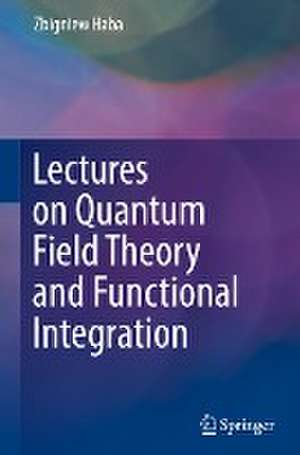Lectures on Quantum Field Theory and Functional Integration
Autor Zbigniew Habaen Limba Engleză Hardback – 30 mai 2023
| Toate formatele și edițiile | Preț | Express |
|---|---|---|
| Paperback (1) | 451.33 lei 38-45 zile | |
| Springer Nature Switzerland – 31 mai 2024 | 451.33 lei 38-45 zile | |
| Hardback (1) | 588.04 lei 6-8 săpt. | |
| Springer Nature Switzerland – 30 mai 2023 | 588.04 lei 6-8 săpt. |
Preț: 588.04 lei
Preț vechi: 691.81 lei
-15% Nou
Puncte Express: 882
Preț estimativ în valută:
112.55€ • 117.04$ • 94.18£
112.55€ • 117.04$ • 94.18£
Carte tipărită la comandă
Livrare economică 14-28 martie
Preluare comenzi: 021 569.72.76
Specificații
ISBN-13: 9783031307119
ISBN-10: 3031307119
Pagini: 235
Ilustrații: XIII, 235 p. 6 illus.
Dimensiuni: 155 x 235 mm
Greutate: 0.53 kg
Ediția:2023
Editura: Springer Nature Switzerland
Colecția Springer
Locul publicării:Cham, Switzerland
ISBN-10: 3031307119
Pagini: 235
Ilustrații: XIII, 235 p. 6 illus.
Dimensiuni: 155 x 235 mm
Greutate: 0.53 kg
Ediția:2023
Editura: Springer Nature Switzerland
Colecția Springer
Locul publicării:Cham, Switzerland
Cuprins
Notation and mathematical preliminaries.- Quantum theory of the scalar free field.- Interacting fields and scattering amplitudes.- Thermal states and quantum scalar field on a curved manifold.- The functional integral.- Feynman integral in terms of the Wiener integral.- Application of the Feynman integral for approximate calculations.- Feynman path integral in terms of expanding paths.- An interaction with a quantum electromagnetic field.- Particle interaction with gravitons.- Quantization of non-Abelian gauge fields.- Lattice approximation.
Notă biografică
Born in 1951, Zbigniew Haba obtained his Ph.D. degree at the University of Wroclaw in 1976, where he then became an assistant professor. Since 1995, he holds a full professorship.
He has spent long periods visiting the Department of Physics of Bielefeld University, and also had research stays in the Department of Mathematics, Bochum University,1988, and the Max Planck Institute, Munich. In 1993, he was the Gulbenkian fellow at Lisbon University, and the visiting professor in Freie Universitaet Berlin in 2000.
Textul de pe ultima copertă
This book offers a concise introduction to quantum field theory and functional integration for students of physics and mathematics. Its aim is to explain mathematical methods developed in the 1970s and 1980s and apply these methods to standard models of quantum field theory. In contrast to other textbooks on quantum field theory, this book treats functional integration as a rigorous mathematical tool. More emphasis is placed on the mathematical framework as opposed to applications to particle physics. It is stressed that the functional integral approach, unlike the operator framework, is suitable for numerical simulations. The book arose from the author's teaching in Wroclaw and preserves the form of his lectures. So some topics are treated as an introduction to the problem rather than a complete solution with all details. Some of the mathematical methods described in the book resulted from the author's own research.
Caracteristici
Connects results of original quantum field theory with methods developed during the last 50 years Provides in concise form mathematical methods applied in modern quantum field theory Allows the reader to conquer the technique of calculations in this field
